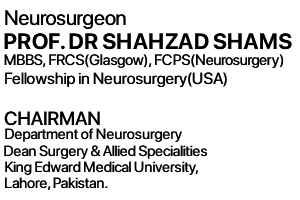Prof. Shahzad Shams presently works as Head and Professor of Neurosurgery Department at Lahore General Hospital, LGH, Lahore.
Trigeminal Neuralgia (Endoscopic Microvascular Decompression)
This is a condition, which may be treated by General PR actioner’s(GPs), Neurologists, Neurophysicians, Psychiatrists and finally end up with Neurosurgeons. It is characterized by a severe spasmodic and lancinating pain, which affects one part of the side of the face. The pain can be excruciatingly severe and may be triggered by various actions, including chewing, swallowing, drinking hot or cold liquids, brushing the teeth, or being exposed to a cold wind.
The exact cause of the symptoms is not precisely known, but the pain usually affects one branch of the trigeminal nerve which supplies sensation to the side of the face. Trigeminal neuralgia can often be adequately controlled with drug treatment alone, for instance Carbamazepine (Tegretol). If, in spite of large doses of medicine, the pain persists or is uncontrollable, there are various surgical measures which can be used.
In many cases symptoms seem to be related to a loop of a blood vessel within the brain itself pressing on the trigeminal nerve. Such loops can sometimes be seen using magnetic resonance imaging (MRI).
The most common surgical procedure is Endoscopic Microvascular decompression MVD. This is a micro surgical procedure where the trigeminal nerve is identified within the skull and any irritating or compressing blood vessels are carefully dissected off the nerve and held away from it using a variety of measures.
Treatment
Endoscopic Microvascular Decompression – MVD
Endoscopic Microvascular decompression is a procedure in which a 2cm opening is made behind the ear and through this opening a endoscope of 4mm size is inserted to find the vessel which is offending the trigeminal nerve which is then separated from the nerve using microsurgical instruments and a small Teflon graft is placed in-between the vessel and nerve. Patient is immediately relieved of the severe pain on the face and is discharged within 24 hours from the hospital.
Results
The results for Endoscopic Microvascular decompression MVD are excellent and once done patient is relieved of the pain forever and permanently. Hospital stay is only for 24 hours.






